
Leyte, officially the Province of Leyte, is a province in the Philippines located in the Eastern Visayas region, occupying the northern three-quarters of Leyte Island. Its capital is the city of Tacloban, administered independently from the province. Leyte is situated west of Samar Island, north of Southern Leyte and south of Biliran. To the west across the Camotes Sea is the province of Cebu.

Ormoc, officially the City of Ormoc, is a 1st class independent component city in the Eastern Visayas region of the Philippines. According to the 2020 census, it has a population of 230,998 inhabitants, making it the second most-populous city in the province of Leyte after the provincial capital of Tacloban. Ormoc is the economic, cultural, commercial and transportation hub of western Leyte.

Abuyog, officially the Municipality of Abuyog, is a municipality in the province of Leyte, Philippines. According to the 2020 census, it has a population of 61,216 people.

Catarman, officially the Municipality of Catarman, is a 1st class municipality and capital of the province of Northern Samar, Philippines. According to the 2020 census, it has a population of 97,879 people.
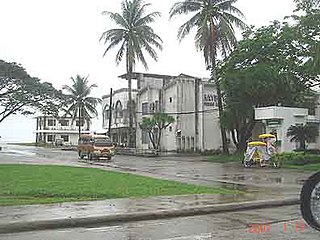
Baybay, officially the City of Baybay, is a 1st class component city in the province of Leyte, Philippines. It has a population of 111,848 people.
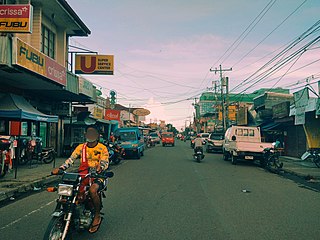
Carigara, officially the Municipality of Carigara, is a 2nd class municipality in the province of Leyte, Philippines. According to the 2020 census, it has a population of 54,656 people.

West Visayas State University is a public normal research university located in La Paz, Iloilo City, Western Visayas region of the Philippines. It was established in 1924 as Iloilo Normal School under the tutelage of the Thomasites, but dates back its founding in 1902 as a part of Philippine normal school system with Iloilo National High School established by the American colonial government. It later became West Visayas State College in 1965 and acquired its university status becoming West Visayas State University in 1986.

The Technological University of the Philippines commonly known as TUP, is a coeducational state university in the Philippines. It was established in 1901 by the Philippine Commission. TUP has its main campus in Manila and satellite campuses in Taguig, Cavite, Visayas, Batangas, and Quezon.

The Bohol Island State University, also referred to by its acronym BISU, is a public institution of higher learning in Bohol, Philippines. It was formerly called the Central Visayas State College of Agriculture, Forestry and Technology (CVSCAFT). The institution operates campuses spread throughout the province, with the main campus in Tagbilaran City, Bohol.

The Philippine Normal University is a public coeducational teacher education and research university in the Philippines. It was established in 1901 through Act No. 74 of the Philippine Commission "for the education of natives of the Islands in the science of teaching". It has campuses in Manila, North Luzon, South Luzon, Visayas, and Mindanao. Pursuant to Republic Act No. 9647, it is the country's National Center for Teacher Education.
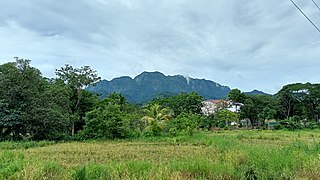
Mount Pangasugan is a mountain in the province of Leyte in the Philippines. It is approximately 1,150 metres (3,770 ft) tall, and located to the north of the city of Baybay. The mountain is densely vegetated, very steep, and home to a remarkable number of plant and animal species. It has been called "the last forest frontier in Eastern Visayas." Mt. Pangasugan Ecopark is situated in the virgin rain forest of the mountain.

Southern Leyte State University is a public university situated in Southern Leyte, Philippines. It is mandated to provide advanced education, higher technological, professional instruction and training in trade, fishery, agriculture, forestry, science, education, commerce, engineering and related courses. It is also mandated to undertake research and extension services, and provided progressive leadership in its areas of specialization. Formerly the Southern Leyte State College of Science and Technology and Tomas Oppus Normal College, SLSU was created through the passage of Republic Act 9261 on March 7, 2004.
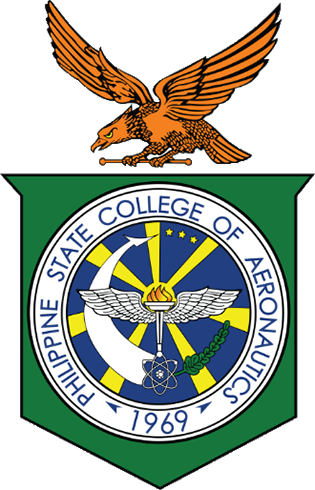
The Philippine State College of Aeronautics is a state college in the Philippines specializing in aeronautics and aviation. Its main campus is in Pasay, Metro Manila, with other campuses located across the country: Floridablanca, Pampanga; Lipa, Batangas; and Lapu-Lapu City. It is the only institution in the Philippines that offers masters and doctoral programs in aeronautical education and management.

Carlos Hilado Memorial State University, also colloquially called by its former acronym CHMSC, is a public, state-owned university, the main campus of which is in Talisay, Negros Occidental, Philippines. It provides preschool, elementary, secondary, higher technological, professional and vocational instruction and training in science, agriculture and industrial fields, as well as short-term or vocational courses.

The Philippine Carabao Center an attached agency of the Department of Agriculture, was established at Science City of Muñoz in Nueva Ecija province in 1992 to breed and cross carabao based on high-yield Murrah buffalo in the Philippines as a multi-purpose animal that can be raised for milk, meat, hide, and draft.

The Eastern Visayas State University is a regional state higher education institution in Tacloban City, Philippines. It is the oldest higher educational institution in the Eastern Visayas region. It is mandated to provide advanced education, higher technological, professional instruction and training in trade, fishery, agriculture, forestry, science, education, commerce, architecture, engineering, and related courses. It is also mandated to undertake research and extension services, and provide progressive leadership in its area of specialization. Its main campus is in Tacloban.
The Laguna State Polytechnic University is a state university in the Province of Laguna, Philippines, with four regular campuses and several auxiliary sites. It is currently classified as SUC Level III.
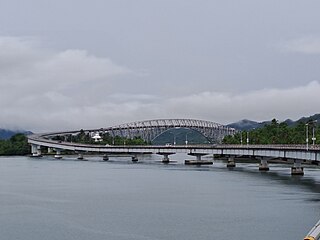
Eastern Visayas is an administrative region in the Philippines, designated as Region VIII. It consists of three main islands, Samar, Leyte and Biliran. The region has six provinces, one independent city and one highly urbanized city namely, Biliran, Leyte, Northern Samar, Samar, Eastern Samar, Southern Leyte, Ormoc and Tacloban. The highly urbanized city of Tacloban is the sole regional center. These provinces and cities occupy the easternmost islands of the Visayas group of islands.

DYDC is a low-power radio station owned and operated by the Visayas State University. Its studios are located at the 2nd Floor, ADE Bldg., Visayas State University, Brgy. Pangasugan, Baybay. DYDC operates Weekdays from 8 am to 5 pm.

Carl Nicolas Cellona Cari is a Filipino politician. He is a member of the Philippine House of Representatives, serving as the current representative of the Fifth District of Leyte. He is the son of the former representative of the Fifth District of Leyte, Jose Carlos "Boying" Cari, and the current mayor of Baybay, Leyte and the late Margarita C. Cari.



















